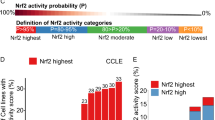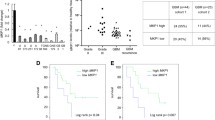Abstract
The dual specificity phosphatases (DUSPs) constitute a family of stress-induced enzymes that provide feedback inhibition on mitogen-activated protein kinases (MAPKs) critical in key aspects of oncogenic signaling. While described in other tumor types, the landscape of DUSP mRNA expression in glioblastoma (GB) remains largely unexplored. Interrogation of the REpository for Molecular BRAin Neoplasia DaTa (REMBRANDT) revealed induction (DUSP4, DUSP6), repression (DUSP2, DUSP7–9), or mixed (DUSP1, DUSP5, DUSP10, DUSP15) DUSP transcription of select DUSPs in bulk tumor specimens. To resolve features specific to the tumor microenvironment, we searched the Ivy Glioblastoma Atlas Project (Ivy GAP) repository, which highlight DUSP1, DUSP5, and DUSP6 as the predominant family members induced within pseudopalisading and perinecrotic regions. The inducibility of DUSP1 in response to hypoxia, dexamethasone, or the chemotherapeutic agent camptothecin was confirmed in GB cell lines and tumor-derived stem cells (TSCs). Moreover, we show that loss of DUSP1 expression is a characteristic of TSCs and correlates with expression of tumor stem cell markers in situ (ABCG2, PROM1, L1CAM, NANOG, SOX2). This work reveals a dynamic pattern of DUSP expression within the tumor microenvironment that reflects the cumulative effects of factors including regional ischemia, chemotherapeutic exposure among others. Moreover, our observation regarding DUSP1 dysregulation within the stem cell niche argue for its importance in the survival and proliferation of this therapeutically resistant population.








Similar content being viewed by others
Abbreviations
- DUSP1:
-
Dual specificity phosphatase 1
- GB:
-
Glioblastoma
- TSC:
-
Tumor stem cell
- DEX:
-
Dexamethasone
- CPT:
-
Camptothecin
- LE:
-
Leading edge
- CT:
-
Bulk cellular tumor
- CTpan:
-
Cellular tumor pseudopalisading around necrosis
- CTpnz:
-
Cellular tumor perinecrotic zone
References
Rong Y et al (2006) 'Pseudopalisading' necrosis in glioblastoma: a familiar morphologic feature that links vascular pathology, hypoxia, and angiogenesis. J Neuropathol Exp Neurol 65(6):529–539
Persano L et al (2011) The three-layer concentric model of glioblastoma: cancer stem cells, microenvironmental regulation, and therapeutic implications. Sci World J 11:1829–1841
Vartanian A et al (2014) GBM's multifaceted landscape: highlighting regional and microenvironmental heterogeneity. Neuro-Oncology 16(9):1167–1175
Li Z et al (2009) Hypoxia-inducible factors regulate tumorigenic capacity of glioma stem cells. Cancer Cell 15(6):501–513
Li Z et al. (2009) Hypoxia-inducible factors regulate tumorigenic capacity of glioma stem cells. In: Cancer Cell. Elsevier Ltd. p 501–513
Vitucci M et al (2013) Cooperativity between MAPK and PI3K signaling activation is required for glioblastoma pathogenesis. Neuro-Oncology 15(10):1317–1329
Raman M, Chen W, Cobb MH (2007) Differential regulation and properties of MAPKs. Oncogene 26(22):3100–3112
Boutros T, Chevet E, Metrakos P (2008) Mitogen-activated protein (MAP) kinase/MAP kinase phosphatase regulation: roles in cell growth, death, and cancer. Pharmacol Rev 60(3):261–310
De Witt Hamer PC (2010) Small molecule kinase inhibitors in glioblastoma: a systematic review of clinical studies. Neuro-Oncology 12(3):304–316
Yu H et al (2012) Constitutive expression of MAP kinase phosphatase-1 confers multi-drug resistance in human glioblastoma cells. Cancer Res Treat 44(3):195–201
Messina S et al (2011) Dual-specificity phosphatase DUSP6 has tumor-promoting properties in human glioblastomas. Oncogene 30(35):3813–3820
Waha A et al (2010) Epigenetic downregulation of mitogen-activated protein kinase phosphatase MKP-2 relieves its growth suppressive activity in glioma cells. Cancer Res 70(4):1689–1699
Wayne J et al (2006) ERK regulation upon contact inhibition in fibroblasts. Mol Cell Biochem 286(1–2):181–189
Sakaue H et al (2004) Role of MAPK phosphatase-1 (MKP-1) in adipocyte differentiation. J Biol Chem 279(38):39951–39957
Laderoute KR et al (1999) Mitogen-activated protein kinase phosphatase-1 (MKP-1) expression is induced by low oxygen conditions found in solid tumor microenvironments. A candidate MKP for the inactivation of hypoxia-inducible stress-activated protein kinase/c-Jun N-terminal protein kinase activity. J Biol Chem 274(18):12890–12897
Lin YM et al (2008) Dexamethasone reduced invasiveness of human malignant glioblastoma cells through a MAPK phosphatase-1 (MKP-1) dependent mechanism. Eur J Pharmacol 593(1–3):1–9
Scarpace L et al. (2015) Data from REMBRANDT. The Cancer Imaging Archive. Available from: https://doi.org/10.7937/K9/TCIA.2015.588OZUZB
Zhang Y et al (2014) An RNA-sequencing transcriptome and splicing database of glia, neurons, and vascular cells of the cerebral cortex. J Neurosci 34(36):11929–11947
Ivy (2015) Ivy Glioblastoma Atlas Project Available from: http://glioblastoma.alleninstitute.org/rnaseq
NCI (2015) The cancer genome atlas; Available from: https://www.cancer.gov/
Galli R et al (2004) Isolation and characterization of tumorigenic, stem-like neural precursors from human glioblastoma. Cancer Res 64(19):7011–7021
Inuzuka H et al (1999) Differential regulation of immediate early gene expression in preadipocyte cells through multiple signaling pathways. Biochem Biophys Res Commun 265(3):664–668
Sahu M, Mallick B (2016) An integrative approach predicted co-expression sub-networks regulating properties of stem cells and differentiation. Comput Biol Chem 64:250–262
Boulding T et al (2016) Differential roles for DUSP family members in epithelial-to-mesenchymal transition and cancer stem cell regulation in breast cancer. PLoS One 11(2):e0148065
Bleau AM, Huse JT, Holland EC (2009) The ABCG2 resistance network of glioblastoma. Cell Cycle 8(18):2936–2944
Hjelmeland AB et al (2011) Twisted tango: brain tumor neurovascular interactions. Nat Neurosci 14(11):1375–1381
Bradshaw A et al (2016) Cancer stem cell hierarchy in glioblastoma Multiforme. Front Surg 3:21
Martinez-Lozada Z et al (2014) Activation of sodium-dependent glutamate transporters regulates the morphological aspects of oligodendrocyte maturation via signaling through calcium/calmodulin-dependent kinase IIbeta's actin-binding/−stabilizing domain. Glia 62(9):1543–1558
Roybon L et al (2009) Neurogenin2 directs granule neuroblast production and amplification while NeuroD1 specifies neuronal fate during hippocampal neurogenesis. PLoS One 4(3):e4779
Shen WH et al (2006) Mitogen-activated protein kinase phosphatase 2: a novel transcription target of p53 in apoptosis. Cancer Res 66(12):6033–6039
Li M et al (2003) The phosphatase MKP1 is a transcriptional target of p53 involved in cell cycle regulation. J Biol Chem 278(42):41059–41068
Liu YX et al (2008) DUSP1 is controlled by p53 during the cellular response to oxidative stress. Mol Cancer Res 6(4):624–633
Lord CJ, Ashworth A (2012) The DNA damage response and cancer therapy. Nature 481(7381):287–294
Esteller M et al (2000) Inactivation of the DNA-repair gene MGMT and the clinical response of gliomas to alkylating agents. N Engl J Med 343(19):1350–1354
Hegi ME et al (2005) MGMT gene silencing and benefit from temozolomide in glioblastoma. N Engl J Med 352(10):997–1003
Ferguson BS et al (2016) Mitogen-dependent regulation of DUSP1 governs ERK and p38 signaling during early 3T3-L1 adipocyte differentiation. J Cell Physiol 231(7):1562–1574
Kim DY, Rhee I, Paik J (2014) Metabolic circuits in neural stem cells. Cell Mol Life Sci 71(21):4221–4241
Li Z, Theus MH, Wei L (2006) Role of ERK 1/2 signaling in neuronal differentiation of cultured embryonic stem cells. Develop Growth Differ 48(8):513–523
Wu JJ et al (2006) Mice lacking MAP kinase phosphatase-1 have enhanced MAP kinase activity and resistance to diet-induced obesity. Cell Metab 4(1):61–73
Meletis K et al (2006) p53 suppresses the self-renewal of adult neural stem cells. Development 133(2):363–369
Cancer Genome Atlas Research, N (2008) Comprehensive genomic characterization defines human glioblastoma genes and core pathways. Nature 455(7216):1061–1068
Li J et al (2001) Transcriptional induction of MKP-1 in response to stress is associated with histone H3 phosphorylation-acetylation. Mol Cell Biol 21(23):8213–8224
Brondello J (1999) Reduced MAP kinase phosphatase-1 degradation after p42/p44MAPK-dependent phosphorylation. Science 286(5449):2514–2517
Acknowledgments
This project was funded by awards from the National Institutes of Health to Marc W. Halterman (R01-NS076617) and Bradley N. Mills (F31-CA180358).
Author information
Authors and Affiliations
Corresponding author
Electronic supplementary material
Fig. S1
Characterization of GB TSC differentiation. Flow cytometry contour plots (a) and geometric mean histogram representations (b) of primitive TSCs (red) and 3-day serum-differentiated dTSCs (blue) for expression of the stem cell marker SOX2, mature glial marker GLAST1, and mature neuronal marker NEUROD1 (n = 1). (GIF 132 kb)
Rights and permissions
About this article
Cite this article
Mills, B.N., Albert, G.P. & Halterman, M.W. Expression Profiling of the MAP Kinase Phosphatase Family Reveals a Role for DUSP1 in the Glioblastoma Stem Cell Niche. Cancer Microenvironment 10, 57–68 (2017). https://doi.org/10.1007/s12307-017-0197-6
Received:
Accepted:
Published:
Issue Date:
DOI: https://doi.org/10.1007/s12307-017-0197-6




